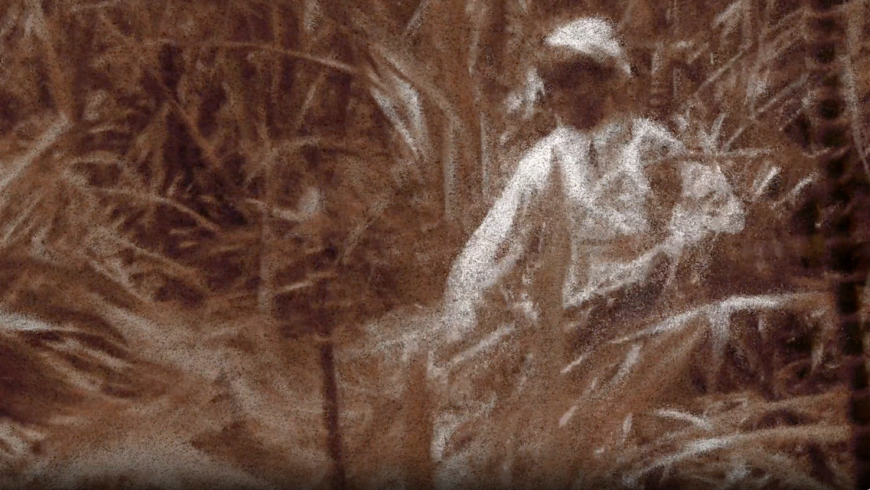Sugar and Sand
Adam Bobbette
Read Adam Bobbette's essay examining the granular connections explored through Gayle Chong Kwan's exhibition—bringing forth the historical and colonial ties between the Isle of Wight and Mauritius.
Projects
Figures emerge from a ground, barely. They are beige and red, pixelated hand-sewn fabric cut-outs in a panorama that spans the wall of the John Hansard Gallery in Southampton. A few kilometres to the south of here is Alum Bay on the Isle of Wight, famous for its Eocene era coloured sands. The panorama is a collage that juxtaposes the Isle of Wight with Mauritius, two islands brought together through their geology (unusual bands of sand) and their troubled histories of British colonialism. In the corner of the gallery is a pile of beige sugar cubes. Large cubes and spheres made of bagasse, a ‘waste’ by-product of the sugar industry, are stacked as precarious structures, that could be offerings, on top of wooden towers at the base of which are sand bags.
Sugar and sand, sweetness and grit; two ways of being granular. The plantation and the Earth, erosion and extraction. Sand and sugar grains are parts caught up with other parts, snug but jagged; piled, heaped, sometimes flowing like rivers from the beach to the ocean, the plantation to the plate. The human body metabolises crystalline calories; the beach is what an island is before it is the ocean floor.
Gayle Chong Kwan’s A Pocket Full of Sand (2024) shows how sand carries stories. Her multi-part installation is a way of thinking about how stories move with matter and pile up. Sand connects human stories with earth stories, strata with bodies. In the panorama, humans appear to emerge from sand, banded like geological strata. In the moving image work, a sandcastle model of Aapravasi Ghat, the colonial era immigration depot for indentured labourers in Mauritius, is set into the tide which gradually pulls it apart, depositing it along the sea floor.
The ancient Roman philosopher Lucretius was also interested in grains. He called the smallest bits of matter atoms. When he tried to answer the problem of how atoms were connected, he imagined what he called a clinamen, a swerve. The clinamen enabled atoms to make larger forms, to cross spatial scales, but also to forge bonds with unlike materials. The clinamen is what the granule needs to hold stories close, for stories to travel, for matter to mean. The clinamen is what connects sand to sugar.
The granular thinking that drives A Pocket Full of Sand is essential today. It helps us to connect individual bodies with planetary and cosmic scales, the energies of deep time with the taste of sweetness, the red sand of Mauritius with the beige of the Isle of Wight. Granular thinking helps us conceive of how stories are things, a kind of cosmic joinery.[1]
Mauritius was in the crosshairs of European colonial interests for nearly three hundred years. The reason was largely for sugar plantations. Dutch, French and British companies vied for the island between the eighteenth and nineteenth centuries, bringing enslaved labourers, and in the 1830s, indentured labour, from across the Indian Ocean, China and the Netherlands East Indies. In the nineteenth century, the island was a centre for abolitionist thinking connected to long range networks of intellectuals in the Indian Ocean world. They dared to imagine a post-imperial and post-colonial world.
The movement of sugar granules from Mauritius and its neighbouring volcanic islands, Madagascar and Réunion, merged into tributaries flowing from the Caribbean and Southeast Asia into Britain. The sugar plantation, with its rationalised labour regime, simplified and mechanised crops, was the engine of industrial modernity. Cheap sugar fed the working classes of Europe as they mined for coal, stoked the steel foundries and operated the mills. Sucrose granules provided calories to be burnt as bodies worked for low pay. Tea, coffee and tobacco supressed appetites, sugar quenched it with a rush. The sweet kernels, in turn, relied on the cheap labour of the enslaved and, later, indentured workers on the plantations. The global class line between the rich north and poor south that we now inherit was drawn by the sugar trade. By the mid-nineteenth century, sugar was an essential part of most Western people’s diets; some even consumed as much as one-third of a pound per person, per day.[2] The sugar granule connected hunger to a global network of labour and asymmetrical profit.

The sands of Mauritius were not overlooked in the time of colonial rule. When Darwin arrived there on the Beagle in 1836, he stuck his hand in the red inland sand while trying to understand how the island came to be. It was clearly volcanic—jagged peaks jut from the centre of the island. Coral encrusted its edges. But he could not understand if the island was one or many volcanoes, and what their story had been. He imagined that the island had risen from the depths of the ocean, that ocean waters had risen and fallen, and that a once massive volcanic neck had split into parts, fragmenting like an orange.
When Darwin was on Mauritius, he was learning to see landscapes in deep time for the first time. His friend, the geologist Charles Lyell, had taught him to think about time in more expansive terms than he had before. Neither Darwin or Lyell knew how old the earth was, they had no number or date to associate with its age. They thought that perhaps it was a few million years old, maybe more. Nailing down the exact number didn’t matter as much as simply knowing it was exceptionally old. Because of Lyell’s influence, Darwin came to think about the history of nature as a series of gradual changes in an immensely long story. This new way of seeing landscapes led Darwin to understand that Mauritius was slowly coming apart and being rebuilt. The volcanic fragments were being laid to waste (eroded) by the action of the sea, which was itself, persistently, rising and falling.[3] Darwin’s new way of thinking about time through geology enabled his later reflections on the gradual transformation of species.
As Lyell was teaching Darwin to think about deep time, it was understood that continents were stable. They could rise or fall but they did not drift. It was not until the 1970s that most geologists came to accept that continents were permanently unmoored. Mauritius came to be viewed as a remnant of a massive and ancient volcanic arc that once connected Réunion and Madagascar to the Indian continental plate. The new plate tectonic vision of the earth’s structure was radical; continents and oceans wandered; our home, Earth, was permanently adrift. Creative destruction is our planet’s essence, we become otherwise than what we are.
We now know that more sediment is moved around the earth by human activity than all natural processes combined. The erosional forces that remove the red sands of Mauritius from inland to the ocean floor, those same mechanical forces acting across the entire earth, is no match for the combined human efforts to dig, scour, and bulldoze. Now it is we who are the global agents of waste. Darwin could not have imagined a world in which humans would be acting as geological agents. In the Victorian vision of nature, humans at most interacted with nature and perhaps were descendants of it, but never were we capable of changing the geological record.
The world that Darwin inhabited, and that we inherit, led to humans becoming actors at a geological scale. The trade in sugar that drove the labour of industrialisation also stoked the chimneys that emitted so much carbon that the earth is entering a new period of warming. The colonial capture of Mauritius by the British, barely a decade before Darwin arrived there, was the ideology of governance and subjugation that enabled the global trade of sugar. That structure also drove the export of coal from the British Isles to be burnt in trains, ships, homes and factories throughout the colonies, which in turn moved more sugar around. We inherit that world as a disassembling climate that will leave its chemical mark in the geological record for eons to come.
A Pocket Full of Sand enables us to trace these links, to think from sand to sugar in the making of our world. In other words, A Pocket Full of Sand presents us with the clinamina of the Anthropocene. The power of Chong Kwan’s granular thinking is that it allows us to bring together sweetness and grit. In the panorama where human bodies emerge from the pixelated red sand landscape, we can begin to understand how social life is geological.
--
Adam Bobbette is a geographer and political geologist who teaches at the University of Glasgow. He is the author of The Pulse of the Earth: Political Geology in Java (Duke University Press, 2023).
--
[1] Geographers have recently become interested in granular thinking too. See, for instance, the work of William Jamieson, “For Granular Geography,” Dialogues in Human Geography 11 2 (2021): 275-293. Jamieson is interested in how thinking with sand grains allows us to connect material and social processes, the scale of the grain with the scale of the state.
[2] Sidney W. Mintz, Sweetness and Power: The Place of Sugar in Modern History (New York: Penguin, 1985), 162.
[3] See Darwin’s interpretation of Mauritius in Geological observations on the volcanic islands, visited during the voyage of H.M.S. Beagle (London: Smith, Elder, 1844), 28-33.

